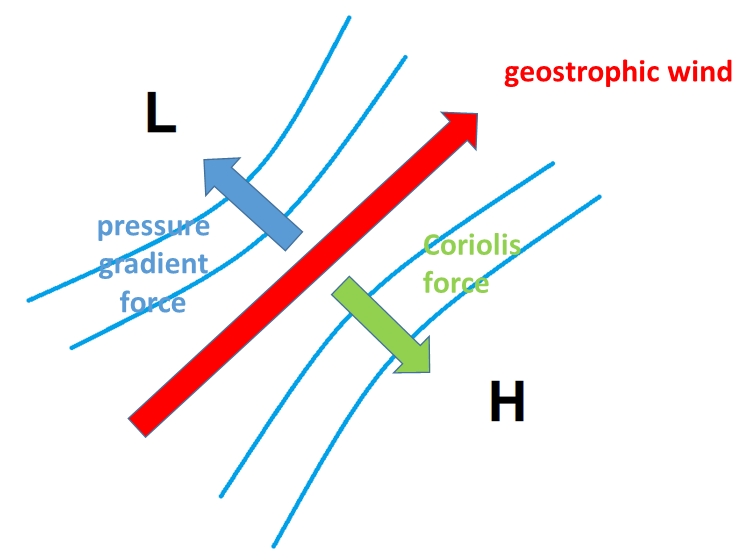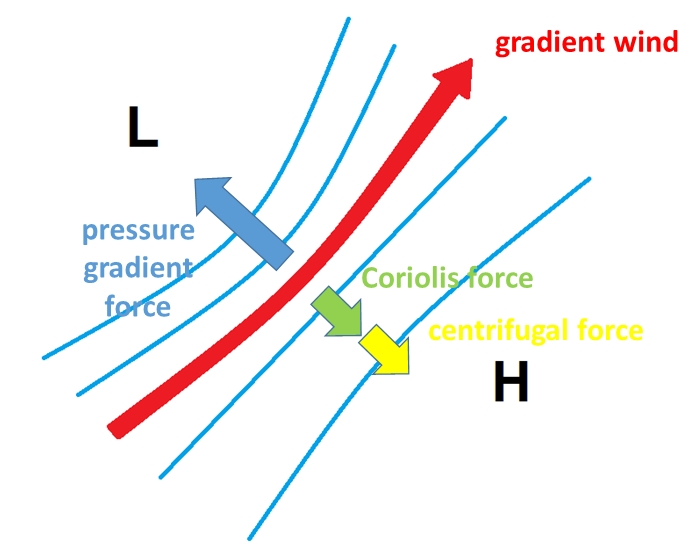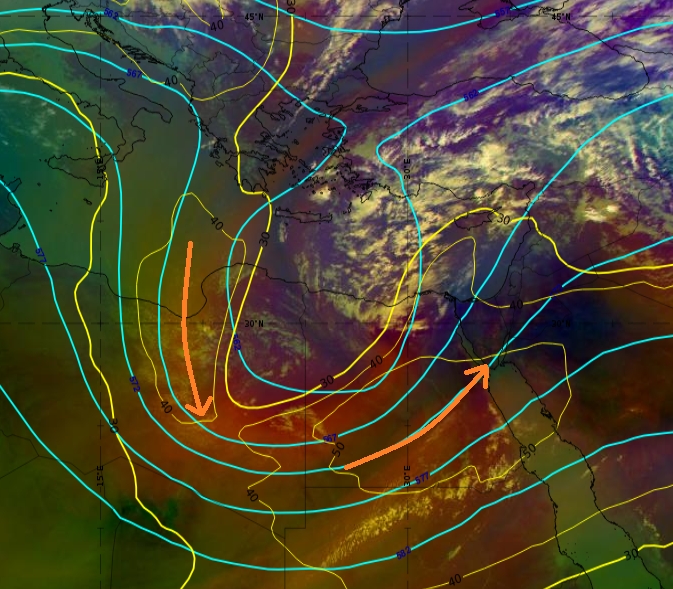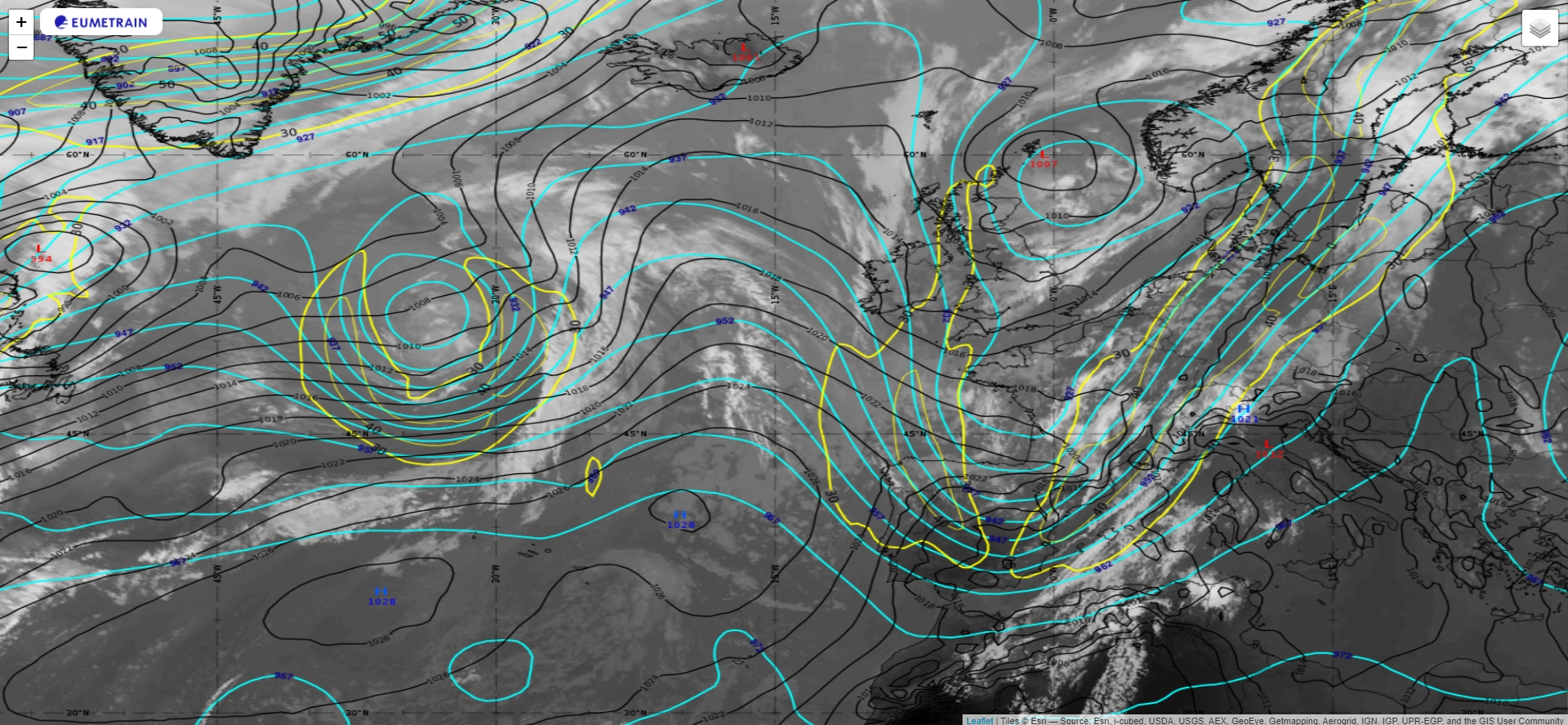Why Don't Jet Streaks Like Strong Curvature?
Let us first look at the dominant forces that act within a jet streak, or more generally on every air parcel that is carried along with the jet stream in the upper troposphere.
In principle, two forces act on the wind at jet level (i.e., around 300 hPa): the Coriolis force, which is a pseudo force since its strength depends on wind speed, and the pressure gradient force, which acts on any air parcel independent of its speed. In a linear jet and in the absence of friction, both forces compensate for each other. This equilibrium is called the geostrophic equilibrium and hence the wind is called the geostrophic wind (see Figure 6).
Figure 6: Schematic illustrating the two forces acting on a linear jet wind in the northern hemisphere.
This equilibrium of interacting forces is true for a linear jet. In the case of a curved jet, a second pseudo force enters into the equation: the centrifugal force, which again is dependent on wind speed and hence a pseudo force. The resulting equilibrium between these three forces is called the gradient wind (see Figure 7).
Figure 7: Schematic illustrating the three forces acting on a curved jet stream in the northern hemisphere.
When curvature increases in some parts of the flow around the tear-off low, the wind speed has to decelerate so that both, the Coriolis and centrifugal forces both of which are pseudo forces that depend on wind speed can be compensated by pressure gradient forces (see Figure 7). Therefore, whenever curvature increases while pressure gradient forces stay the same along the jet's trajectory, wind speed deceleration is necessary. This is a common situation for a cut-off low during the tear-off process and this is also why we usually observe jet streaks on both sides of a trough and not at its southern tip where curvature is strongest.
As shown in Figure 8, the wind speed of the jet stream clearly decelerates when the airflow turns around the sharp edge of the upper-level trough. The pressure gradient force at the southern tip of the ULL, where curvature is strongest, does not increase in order to compensate for the Coriolis and centrifugal forces. As a result, the wind speed has to decrease to make it round the "corner".
Figure 8: Airmass RGB from 3 February 2021 at 12:00 UTC. Isotachs at 300 hPa are depicted in yellow and the geopotential height at 500 hPa in cyan. The orange arrows mark the position of the jet streaks.
Note:
Whether a jet streak is split into two branches or not when circling a trough or an upper-level low mainly depends on the interplay of pressure gradient and curvature. Upper-level lows with a uniform pressure gradient tend to have a continuous wind speed along the jet's path while troughs with a sharp southern edge tend to show split jet streaks on each side of the trough.
Figure 9: IR 10.8 μm from 7 July 2021 at 18:00 UTC. Isotachs at 300 hPa in yellow, geopotential height at 300 hPa in blue and mean surface level pressure in black.
The example above (see Figure 9) shows a pronounced trough over western Europe and an upper-level low over the Atlantic. The weather situation can be classified as low index circulation and both features are located amid warm air far south of the polar front: a meteorological condition that is typical for northern hemispheric summer.
While pressure gradient forces increase south of the ULL (feature on the left) and thus compensate for the Coriolis and centrifugal forces, the pressure gradient merely stays constant for the airflow contouring the southern tip of the trough (feature on the right). This results in a constant wind speed around the ULL, while the trough has a wind speed minimum near the place of strongest curvature.



